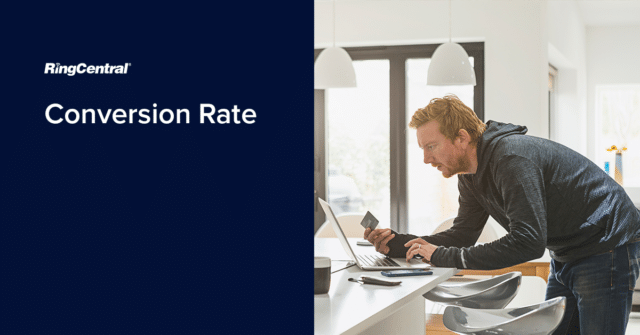Starting an eCommerce business isn’t a simple task. The work doesn’t stop once you’ve outlined your business strategy, built your store, set up your product pages, and executed your marketing efforts. Once all that’s done, you still need to convert website visitors into valuable leads or customers effectively.
Converting customers might seem like a simple task. If they like the product, they’ll buy it.
Not quite.
Countless factors come into play when we talk about converting website visitors to customers, bringing us to the topic at hand: conversion rate.
What is the conversion rate?
Conversion rate refers to the number of visitors to your website or landing page who take the desired action, which – put – means they do what you want them to. Conversion can mean a variety of things depending on your industry and business goals.
Among the most common types of conversions and micro-conversions (an indication that a user is progressing towards taking a valuable action) are:
- Making a purchase
- Completing and submitting a form (like a lead generation form)
- Getting in touch via phone call, email or online chat
- Subscribing to something (like a newsletter)
- Registering an account with your website
- Downloading a resource (e.g. a software trial, eBook, white paper, etc.)
- Upgrading a product or service
- Engaging in another way
Regardless of the business you’re in, and it’s important to remember that conversion doesn’t simply happen; it requires skilled optimisation. Whether you’re an eCommerce manager or a digital marketing specialist, conversion rate is a key metric that provides essential insight into any business or campaign’s success.
Understanding online store conversion rates
An eCommerce conversion rate refers to the number of visitors to your website who make a purchase from your online store in a specified time period. Google Analytics provides the standard reference for conversion rates by dividing sales transactions by visits. Google defines eCommerce conversion rates as:
“The ratio of transactions to sessions expressed as a percentage.”
Of course, buying a product or a service isn’t the only key performance indicator (KPI) that you can use to measure your eCommerce site’s success. Other typical eCommerce micro-conversions include:
- Adding something to a shopping cart
- Adding something to a wishlist
- Signing up with an email address
- Sharing something on social media
Conversion rate is a barometer by which you can measure your eCommerce website’s overall performance and competitiveness.
Why is it important?
So why is conversion rate an important metric for your online store?
The main reason is that tracking conversion rates enable you to measure how well your business is performing. Understanding how many of your website visitors are completing the desired action is key to gauging what you’re doing right and what needs improvement.
Improving conversion rate with conversion rate optimisation (CRO) techniques allows online retailers to make the most of their site traffic, which leads to more sales and – ultimately – more money.
What is a good conversion rate for eCommerce?
According to Wordstream, the average conversion rate across industries is 2.35%.
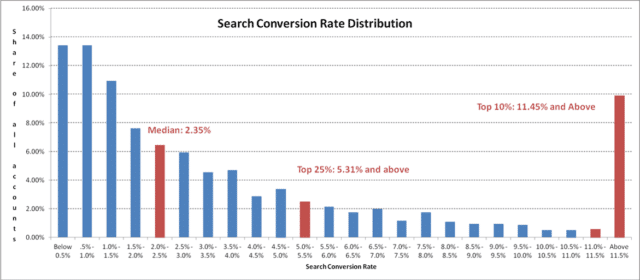
However, the average rate for eCommerce is lower, coming in at just 1.84%.
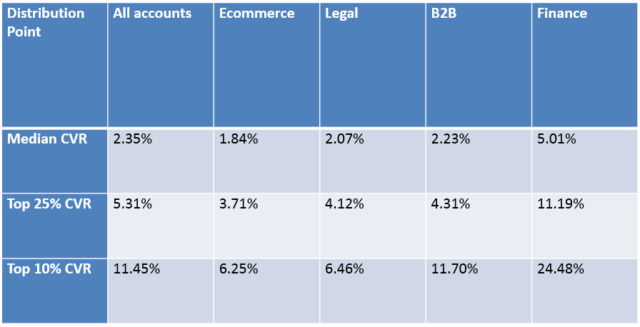
We can say that a “good” conversion rate for eCommerce is anywhere between 1-3%, in line with average online store rates across the globe. Of course, the higher the conversion rate, the better! Another way to look at it is that “good” is simply a higher conversion rate than the last time you measured!
However, many variables come into play when looking at ideal conversion rates. Conversion rates can vary depending on the sector, region, season, online marketing presence, website user experience etc. It also depends on what you consider to be conversions. Some of the variables that impact conversion rate include:
- The type of product being sold
- Cost or average order value
- Traffic source
- Device (desktop, mobile, tablet) and platform (iOS, Android, Mac, Windows, etc.)
- Customer demographics and location
For instance, an eCommerce site selling high-end tech gadgets is unlikely to have the same conversion rate as a store selling cheap clothing. Also, note that mobile devices’ average conversion rate is much lower (1.53%) than on desktops (4.14%).
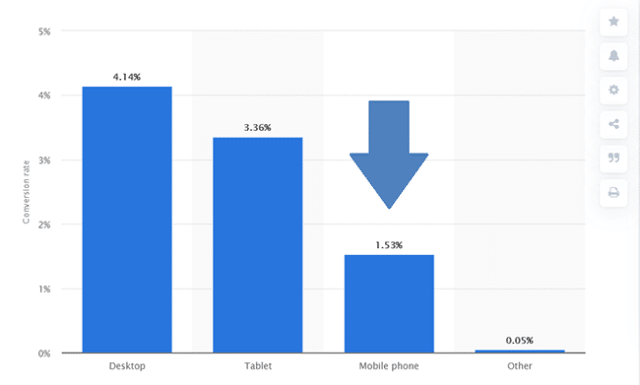
Moreover, the conversion rate is usually used to refer to the percentage of website visitors that become paying customers, whereas businesses might have different conversion goals. Therefore, it’s important to measure other metrics (unique visitors, click-through rate, bounce rate, etc.) to boost your store conversion rate.
The key to understanding your eCommerce conversion rates is to look at average rates across industries and use them as benchmarks for your performance. When you know you’re meeting your industry’s average conversion rate, you can begin taking informed actions to optimise that rate and achieve your business goals.
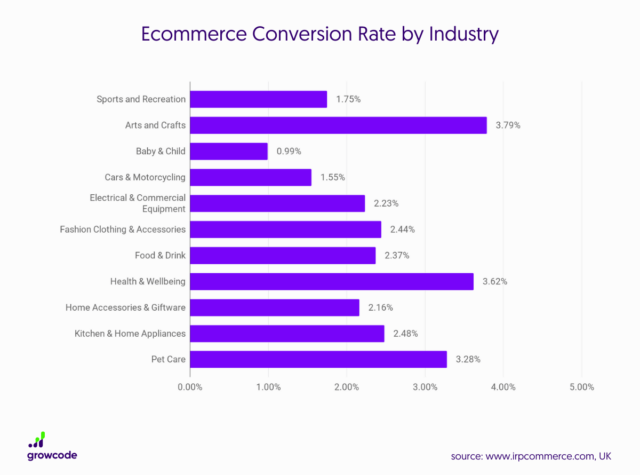
How to calculate the conversion rate for an eCommerce website
Calculating the conversion rate for an eCommerce site is simple. All you need to do is divide the total number of conversions by the total number of visitors and multiply by 100. For instance, if an eCommerce website receives 500 visitors a month and has 100 sales, the conversion rate is as follows:
100 / 500 x 100 = 2% conversion rate.
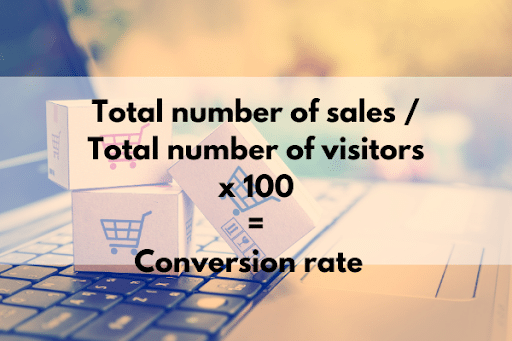
How to improve eCommerce conversion rate
Now that you know exactly what conversation rate is and why it’s important, you’re probably wondering how you can improve it to achieve better business results.
That’s where conversion rate optimisation (CRO) comes in. CRO is the process of improving the online shopping experience to drive a specific conversion metric. CRO is carried out by analysing why website visitors aren’t converting, coming up with actionable strategies to improve conversions, and using A/B testing to see if those ideas are successful.
CRO can be carried out on a landing page, category page, product page or any other customer touchpoint on your website. Let’s take a look at some actionable steps you can take to improve your online store’s conversion rates and come closer to achieving your business goals.
Conversion rate optimisation steps
CRO is kind of like an art. However, unlike art, CRO doesn’t depend so much on inherent talent but rather on the tools and strategies marketers leverage to execute it. Below are some steps you can take to improve your eCommerce conversion rates.
1. Use high-quality product images and videos.
There’s nothing more frustrating than buying something from an online store, only for it to arrive and look nothing like the image on the website. In the same way, bad-quality images can put people off buying your products in the first place!
Be sure to use high-quality, professional-looking images that really show off how great your products are. Moreover, use lots of them. You can even offer close-up or zoomed-in versions to show material and texture. This way, the customer knows exactly what they’re getting.
Another option is to include product videos that provide 360-degree views of products. People are more inclined to purchase items when they know precisely how they look in real life.
2. Write exceptional product copy.
When it comes to creating product pages that convert, it’s important to ensure your copy is succinct without skipping out on essential details that customers need to know to make a purchase. Ensure you cover all the basics with your copy, but avoid long descriptions as this will put people off – especially if they’re browsing on mobile.
When it comes to copy, wherever it is on your website, you should consider using search engine optimisation (SEO) and CRO in tandem to boost site traffic and conversions. This requires you to consider three major things that impact Google’s ranking algorithm:
- Keywords and on-page SEO
- Quality of content
- User, usage and usability data
Conducting and implementing keyword research and SEO practices on your eCommerce site will attract potential customers. Once you’ve implemented an SEO strategy, you can use Google Analytics tools to analyse whether your copy is successfully converting customers.
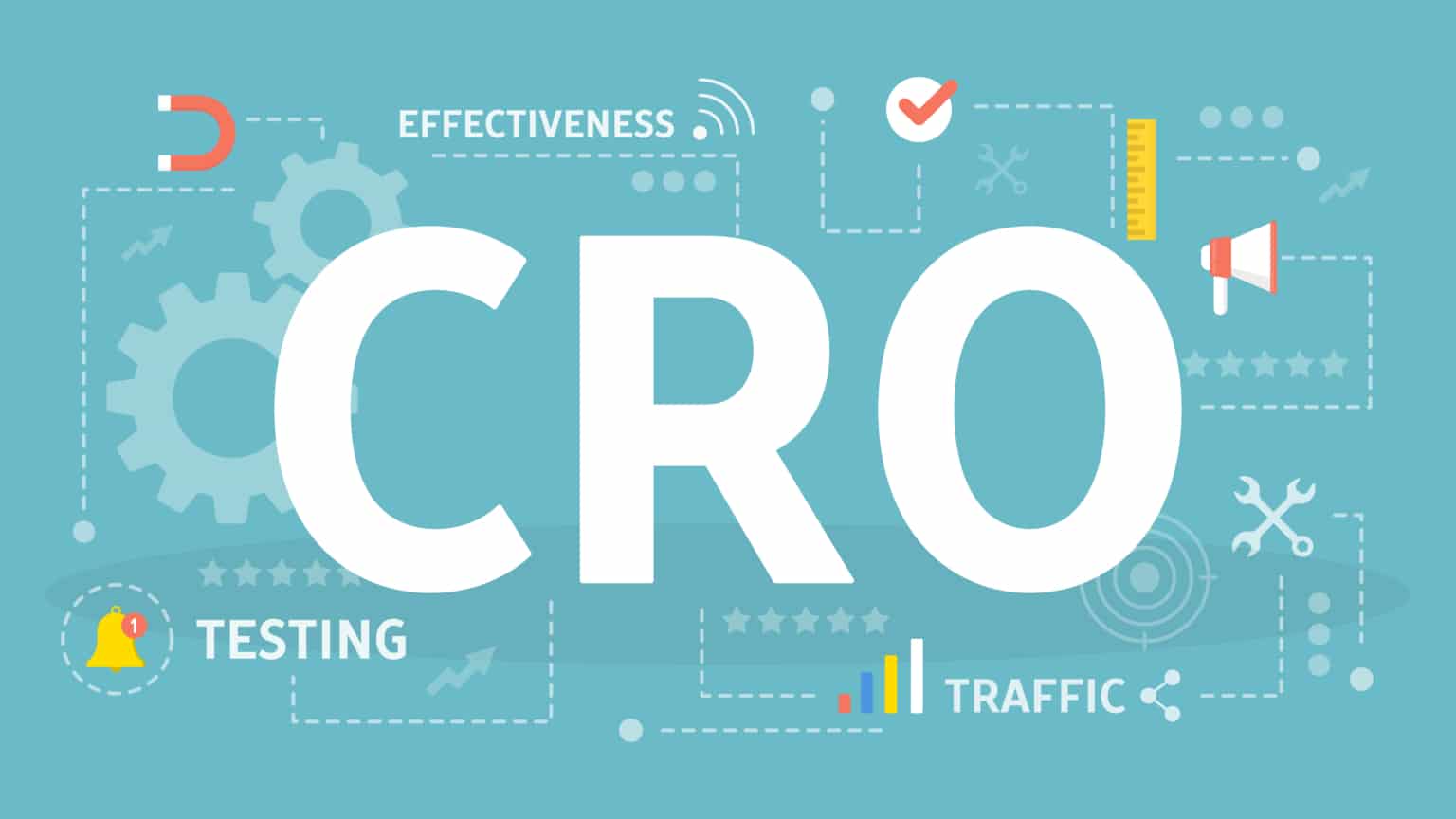
3. Leverage social media as a shopping platform.
Advertising and creating an organic presence on social media channels like Facebook and Instagram are tried and tested to boost traffic and conversions.
The average Google Ads (previously Google Adwords) conversion rate on mobile devices across all industries is 3.48% on the search network and 0.72% on the display network. Moreover, according to Wordstream, the average Facebook Ads conversion rates across industries is 9.21%.
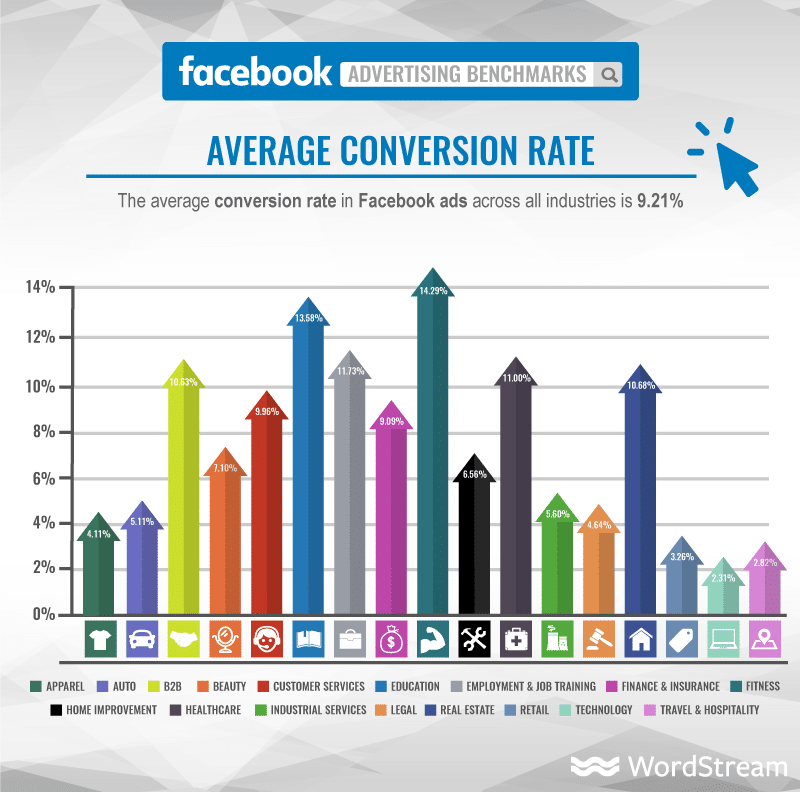
However, more and more eCommerce businesses turn to social media to directly sell their products and services. This practice is prevalent in industries that rely on visual presentation, such as retail. By making your social media pages shoppable, you can use your existing digital marketing efforts to boost conversion rates directly.
4. Offer free shipping.
Some 50% of consumers abandon their shopping cart during checkout due to extra costs like shipping, taxes, and fees being too high. What’s more, 75% of customers have come to expect it. A simple way to combat this and improve conversions? Offer free shipping!
Offering customers free shipping provides them with an incentive to buy before they’ve even selected a product. People love free stuff, so why not use this to your advantage?
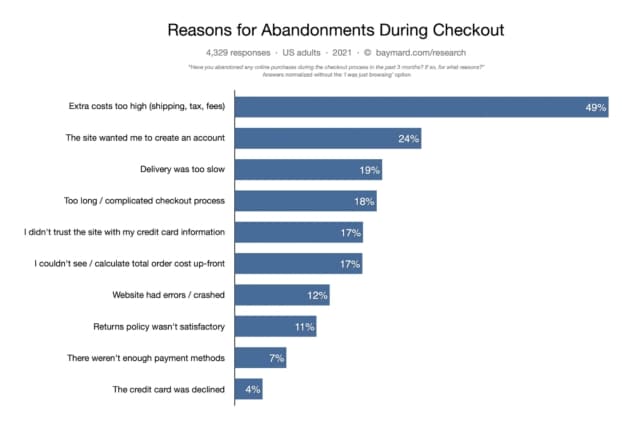
6. Optimise for mobile devices.
If your eCommerce site isn’t optimised for mobile, you’re guaranteed to be missing out on conversions. Moreover, if you don’t offer mobile eCommerce, you’re inevitably missing out on a huge pool of potential customers that won’t even have the chance to convert!
In the UK, 55% of people use their mobiles to shop online. Your eCommerce store should be just as simple to navigate on a mobile as it is on a desktop. This will ensure mobile visitors don’t become frustrated with your site and drop off before they convert.
7. Streamline checkout.
A key step when it comes to CRO is to streamline the checkout process. 21% of consumers abandon their shopping carts before completing the purchase because the checkout process isn’t straightforward enough. Ensure your checkout is quick and convenient, and all costs are visible upfront. Experiment with different checkout pages and A/B test them to see which ones work best to convert customers.
8. Integrate live chat software with your eCommerce site.
Providing your customers with a live messaging option to connect with a customer support agent can do wonders for your eCommerce conversion rates. If people have questions about a product or the checkout process, a pop-up chat box that allows them to find quick answers can be the difference between someone leaving your site or converting.
A live chat solution also creates a personal connection between your business and the customer, encouraging them to come back in the future. However, it’s important to provide 24/7 support to customers to ensure a lack of immediate response doesn’t lead to further frustrations. If you have the budget, chatbot software provides a viable solution.
9. Test, test, and test again.
When it comes to improving conversion rates, the key to success is consistent A/B testing. This allows you to test two versions of pages against one another to understand which performs better. When split testing, it’s important to look beyond making cosmetic changes if you want to see big results. Here are some CRO ideas you can A/B test:
- Experiment with page redesigns like minimalist designs, different layouts, product copy etc.
- Experiment with offers and sales to see what works for you and your customers
- Try out different traffic sources by sharing the same landing page on different social media/advertising channels.
When you consistently test how your eCommerce site is performing and converting customers, you’ll be able to use your findings to inform future business strategies and take your conversions to the next level.
Tools to improve eCommerce conversion rates
Did you know that companies spend, on average, $2000 on CRO tools? Though this seems like a lot of money, if the tools do indeed help you to optimise your conversion rate, then they’re probably worth investing in.
CRO software tools are becoming more advanced by the day, leveraging the latest technology trends, like automation and artificial intelligence (AI) technology, to improve the user experience and encourage conversions.
Here are some essential tools to add to your tech stack to improve conversion rates.
Hotjar:
- Hotjar is a heat-mapping tool that allows you to understand exactly how visitors are interacting with your website. It allows you to analyse customer behaviour in real-time while providing you with an overview of how different users navigate your website.
Google Analytics:
- Allows you to track and analyse:
- How visitors interact with your website (how long they spend on a page, bounce rate, etc.)
- What device, operating system, and browser they’re using
- Where they’re from and how they found your site
- How many converted
Optimizely:
A key tool for A/B testing your website. Optimizely is a split testing and multi-page test tool that’s intuitive and easy to use. It’s an experimentation tool aimed at enterprise-level businesses and allows businesses to extract insights about browser behaviour, demographics, and third-party data.
Key takeaways
The key to converting customers is understanding their needs. Once you know what your customers expect from your business, you can take actionable steps to improve the user experience and encourage them to convert.
When it comes to CRO, implementing the right tools to track and analyse your efforts is just the first step. Converting customers is about offering them an experience that no other eCommerce store could and keeping up with the latest eCommerce and customer experience trends to stay ahead of the game.
Now more than ever, it’s crucial for businesses to stay connected to their customers at every step of their customer journey. Implementing a unified business communications solution like RingCentral Office allows you to do just that.
With integrated phone, video and messaging, you can stay connected to your customers in-store, online, and every step in between with the click of a button.
Originally published Apr 22, 2021, updated Dec 13, 2023
